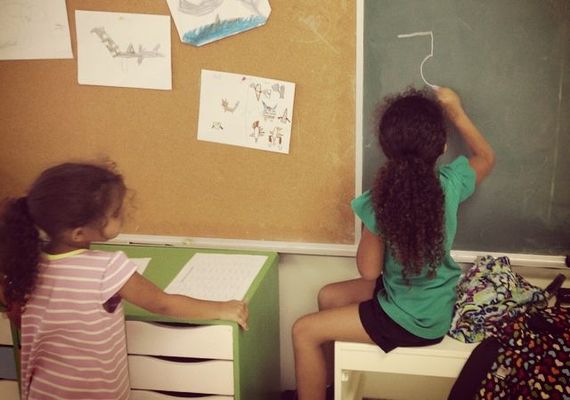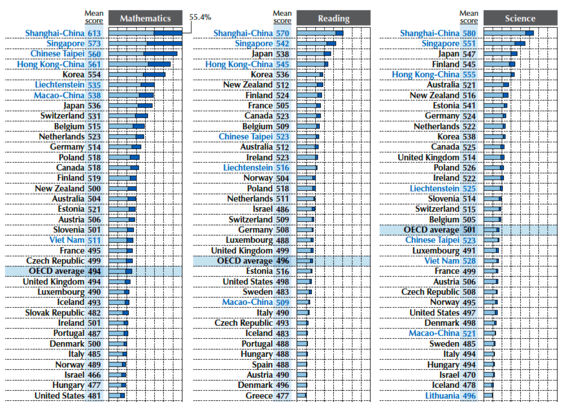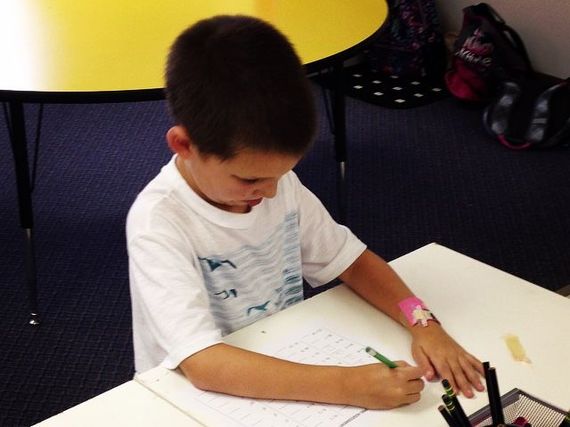As China, India and the East continue to pump out math prodigies from an early age, the U.S. children continue to lag further and further behind. According to PISA results, the U.S. math world ranking has dropped again from 25th in 2011 to 31st in 2012.
I believe this still might be generous for many of our U.S. kids. This past year, I was guest teaching math and science across all K-12 grade levels, and many of the high school students still didn't have a solid handle on long division which is typically taught in fourth grade. I later found this to be endemic in many of our schools and kids across the country. Yet, the Asian countries do not teach math that differently than we do in the U.S., and the content for math is practically the same across the world. So how are the Asian countries so much further ahead of us?
I believe a primary reason for this is 'culture.' The vast majority of the U.S. school and educational culture is not as academically focused as the competing Asian cultures. The Asian tiger culture highly revolves around pushing their children to do better and better in school with strong reinforcement from their parents, teachers, and their entire social and peer group.Education is emphasized heavily in these countries because, in many cases, it is their only path to financial freedom and survival. Ranking in the top 3 of their class means they actually have an opportunity to go to college, which could lead them to securing a job that can support a family. However, the competition is fierce and their academic curriculum is rigorous, so they have to work really hard just to pass.
The U.S. educational culture is more focused on doing well in sports or being popular. In many cases, these priorities lead kids to being rebellious or defiant, and sometimes not doing well in school, just so they're not perceived as a nerd. The parental reinforcement is also lacking because a significant amount of households today are dual working parents, or single working moms. What ever time and energy they may have remaining after work tends to be focused more on feeding their children then actively helping them with their studies.
I don't see the U.S. transforming into a tiger culture anytime soon. However, our current approach of outspending other nations isn't working either. According to the OECD, the U.S. is currently one of the top spenders of all developed nations with around $115,000 per student. Yet, countries like Hungary, Poland and Slovak Republic received a similar PISA score to us, but spend less than half the amount the U.S. does. Top performer New Zealand spends less than $30,000 per student.
However, if the U.S. is known for any one trait, that would be innovation. I believe we can leapfrog the Asian countries, and the world, by teaching math in a different and much more efficient way.
I was asked to tutor a 6-year old boy named Brad, who was starting first grade, for an hour a night for four nights a week. Brad was your average kid who came from divorced parents with a single mom who was so busy working to keep food on the table, that she would feed him microwave dinners and use the TV or gameboy to keep him distracted while she worked to keep up with the house. When he was with his father, he received even less attention. He had a lot of suppressed anger which would often erupt into temper tantrums and other behavioral issues including a self-defeating attitude. He also had a hard time focusing on anything except the next game he wanted to play and was diagnosed with ADHD.
With full cooperation of his parents, the first thing I did was take away his screens (TV, computer, gameboy, phones, tablets, etc.) and give him allocated screen times such as 30 minutes a day for one TV show or a game during weekdays, and two hours per day on weekends. In place of the extra screen time, he was offered paper to draw on, physical toys like legos where he could build something, or doing something outside. After 2 weeks of limited screen time, I had his focus back and his parents didn't have to put him on any medication. Over time I would reward him more screen time courtesies, and incentivize him with creative games like MineCraft.
In those two weeks, I also helped Brad learn about emotional management. Every time he was angry or difficult about something, I asked him to sit on the couch until he understood why he was angry. The couch was not to signify punishment, but was a seat facing away from any distractions so he could self-reflect on his actions. I told him to keep taking deep breaths until he calmed down and could tell me why he was angry. When he could tell me why, I would ask him if he was still angry and in most cases the answer was no. I would then let him continue with what he was doing. After 2 weeks of this approach, he started to catch himself when he felt his anger building up and would excuse himself and sit on the couch until he calmed down. In 1 month, his anger and other behavioral issues subsided.
I would also feed Brad only healthy nutritional food when he was with me, mainly fruits, and vegetables, and usually organic. I asked his parents to remove all soft drinks and other sugary and salty foods from his diet. There are numerous studies that show foods heavy in processed sugars, salts and preservatives, such as health bars, cereal, microwave dinners, sodas, juice boxes, potato chips, fruit wraps, candy, fried foods and more, not only lead to severe health issues, but also have a detrimental mental and emotional impact on a kid's ability to learn, and can also lead to depression.
Over the weeks, I noticed that removing screen time, adding proper nutrition and enforcing emotional awareness had a significant impact on Brad's capacity to learn.
During this time, I took the following teaching steps to help Brad climb up the math ladder:
Step 1: When I started with him, his class was learning single digit addition (2 + 3 = 5). After helping him with basic addition, I taught him basic rules of math, such as adding anything to 0 is the same number, multiplying anything by 0 is 0, when multiplying anything by 10 you add a 0 to that number, and so on.
Step 2: Once he had the basic rules and shortcuts down, I had him fill out a 20 x 20 times table. Most schools teach up to 10 or even 12, but I wanted Brad to notice number patterns and it's hard to see them unless there's enough runway, so that's why I took it to 20. As he worked through each times table, starting with the easy ones first, I would help him count his way up the 2's, than 3's and so on. At first he would use crayons to count up, and after he gained some confidence he started using his fingers.
Step 3: When he got past base 10 (i.e. 11x, 12x, etc.), I would have him break up the number into 10 plus the number, so 12 would be 10 + 2. He would then add this to the previous answer in the times table, so 12 x 14 would be the 12 x 13 answer, 156 + 10 + 2, instead of 156 + 12. When the base numbers were higher such as 19, then I would suggest to break this number up into +10 + 10 - 1, so 19 x 2 would be 19 + 10 + 10 - 1 = 38. This seemed to be easier for him to understood and faster for him to solve, while also teaching him addition and subtraction with repetition so it would stick.
Step 4: After he completed the times tables, he would go back and search for patterns. For example, in the 9's, the right side of the answers starts with 9 and counts down to 0 where the left side would start at 0 and count up to 9 (09, 18, 27, 36, 45, 54, 63, 72 , 81, 90) and the cycle would repeat. Also if you add each of the answers's digits together, they always reduce to 9 (27 => 2 + 7 = 9). Each times table base number has a pattern, so he would look through them and discover different perspectives for coming to the same answer. This deepened his understanding of each table and how all these numbers correlate to each other.
Step 5: After he finished, I would have him repeat doing the times tables all over again with this fresh understanding. He did the full times table a total of 4 times and by the 3rd time, he had developed so much confidence that he actually liked math and wanted to learn more.
Step 6: Once he had a handle on the times tables, I would go to the next step and teach exponents by circling all same digit multipliers like 2 x 2's, 3 x 3's, 4 x 4's, and so on, and explain another way of writing them is 2^2 which is also referred to as 2 squared. This became a vocabulary lesson, and once he got it, I would then show him the opposite is a square root so the √81 = 9 because 9 x 9 = 81. At first, when I gave him these problems to solve, I would have him refer to the times table to get the answer, however it didn't take him long to know them on his own.
Step 7: Division came next, where I showed him how to reverse the multiplier. So where 4 x 3 = 12, then 12 / 3 = 4 or 12 / 4 = 3. Once again I would give him problems allowing him to use the times table to find the answers, but after a while he would just know them without having to look.
Step 8: Once these principles were clear, I would teach him long form addition followed by long form multiplication, and then long form subtraction followed by long form division. Since he knew how to break up numbers into smaller fragments, he picked up the concept of how to carry numbers pretty quickly.
Step 9: After Brad was proficient in all these steps, I taught him other concepts in this order: order of operations (PEMDAS), fractions, decimals, reciprocals, multiplying and dividing fractions, adding and subtracting fractions, all which led to solving for X in basic algebra equations, such as 2/3X + 122 = 194.
In addition to solving for basic algebra equations, Brad (remember, he's only 6 years old) also learned to graph various equations, calculate the areas of squares, rectangles, and triangles, work with money, measure time and more by the time December rolled around and his 4 month semester was over.
The social impact on Brad was also fascinating. After 1 month, Brad's original attitude of not wanting to go to school and always coming back sad or depressed, began to shift to being excited and wanting to go to school. After 2 months, when he was asked how his day went, he would always report something positive. After 3 months, he was much more centered, very social and made friends easily. In the 4th month, he exuded confidence and even talked a bully down from harassing his classmates.
At this pace, if I continued teaching Brad in this modified pattern-building approach, I believe I could have carried him to calculus by 4th grade. Not only would he be far ahead of kids in Asia, but this would give him the next 8 years to apply these math concepts and principles to learn different sciences such as physics, chemistry, biology, earth sciences, astronomy, engineering and computer science, and apply this knowledge to real world themes such as solving problems for the environment, energy, food, water, health, space and more (see article: STEM Contest Inspires Kids to Invent Our Future).
Beyond the prepping, teaching and other techniques, there was one key element that allowed this entire process to work for Brad or any student I've taught. I believed in him. I respected him and knew he could do it regardless of all the hurdles he faced and how many times he wanted to give up. At first it was my belief in him that kept him going, but eventually he hit a tipping point and developed his own self-confidence and began to propel himself. This is when I realized that all kids (and adults) want to learn and grow. Sometimes they just need someone to help them feel worthy and capable of learning without feeling judged. Brad confirmed this on the last day when he gave me a big hug and said, "thank you for making me smarter."


